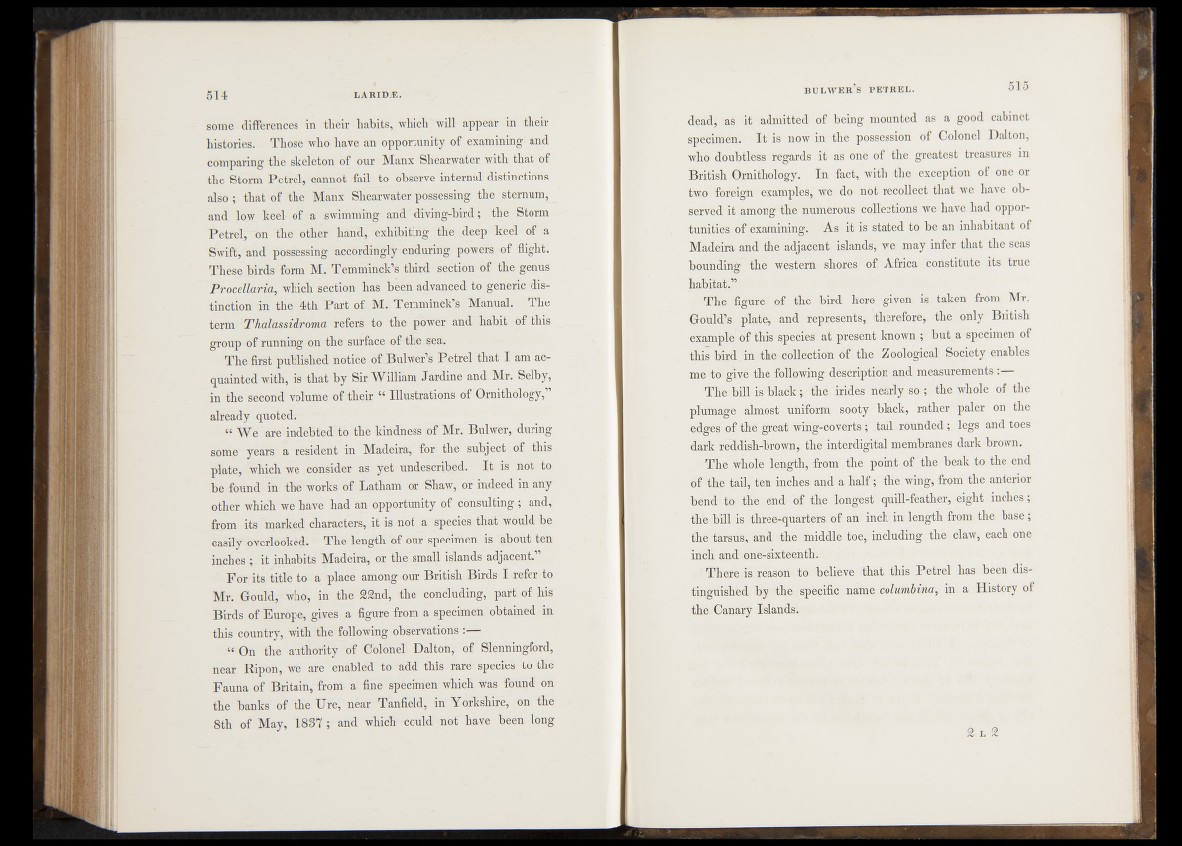
some differences in their habits, which will appear in thétr
histories. Those who have an opportunity of examining' and
comparing the skeleton of omr Manx Shearwater with that of
the Storm Petrel, cannot fail to observe internal distinctions
also ; that of the Manx Shearwater possessing the -sternum^
and low keel-of a swimming and' diving-bird ; the Storm
Petrel, ~on the other hand, exhibiting the,,deep’keel of a
Swift, and possessing accordingl-jrenduring powers, of- flight1.
These birds form M. Temminck’s third section of "the, genus
Procellaria, which section has been advaneed"tovgeneric; distinction
in the 4th Part of M. Temmincks Manual. The
term Phalassidroma refers to the power andT habit -of this
group of running on the surface of-the Serf.-
The first published notice ofiBulwer’s Petrel that I am acquainted
with, is that by Sir William Jardine and-Mr. Selby,
in the second volume of their “ Illustrations of Ornithology,”
already quoted.
I W e are indebted'to the kindness of Mr. Bulwer* during
some years a resident in Madeira, for the subject of this
plate, which we jconsider as yét undescribed. It Is not to
be found in the works öf Latham or riffled in.àdj*
other which we have had an opportunity óf. consulting ; and,
from its marked characters^ it is not a species that would be
easily overlooked. The length of our specimen-is about ten
inches ; it inhabits Madeira, or thesmall islands adjacent.
' For its title to a place among our British Birds I refer to
Mr. Gould," who, in the 22nd, the concluding, part of his
Birds of Europe, gives a figure from a specimen-obtained in
this country, with the following observations
« On the authority of Colonel Dalton, of Sl'enningford,
near Ripon, we are enabled to add this-rare* species'to the
Fauna of Britain, from*- a fine specimen which was found' on
the banks of .the Ure, near Tanfield, in Vork shire, on the
8th of May, 1837 ; and which could not have been long
dead, aS it admitted of being mounted as a good cabinet
specimen. Ik is now idtfhe possession of Colonel Dalton,
who* dbubtless* regards*it" a s 'éne of the greatest treasures in
British Ornithology^ In fact, with the exception of one or
two foreign 'examples^ we' do not recollect that we have ob-
Setyêfitut among'f%{ëm1|fiieïous 'collections we haye had oppor-
tü fiftl^o f examiningr 'As ife is stated to be an inhabitant of
Madeira and the adjac'ehrflands, we may infer that the seas
bounding' the westerïfyènbfe^ of Africa constitute Its true
habitat.”
The figure- of .the bird herehgiven. is, taken from Mr.
Gould’s /piatef?sand represents, therefore, the only British
example of thisfspeqfes at present known ;i’.b;ut a specimen of
this bird in the Qóllcctiömoi^the^ Zoological, Society enables
me to'gritthl|S|fi,wiilg description and measurements:;—
The b illis 'black; the^iïidés 'nearly the. whole of* the
p lu ü a g e a lm o stuniform sooty" black, rather paler on the
edges'of-the1'great.wing-cóv^ïti; ,tail rounded; legs and toes
dark reddish-brown, the interdigital membranes dark brown.
.The whole ljel^tih^from the point of the beak,teethe end
of’the tail, ten inch|fs|and a half ;.ifhe wingy from the anterior
bend: tö ’flbrend of the'ilongesthquill-feather, eight inches;
thfeélMlthreè-quarters of an inch,-in length.from the base;
the tarsdsy, and fhe*.middle foeyinefuding the daw, each one
inefiiand' one-sixteenth.
j There is reason to ?belfeve Hhat this Petrel has been distinguished
by the specific name columbina, in a History of
thé. Canary Islands.
2 l 2